Chapter 10 PDF

| Title | Chapter 10 |
|---|---|
| Course | PROFESSIONAL AND TECHNICAL COMMUNICATION FOR SCIENCE AND ENGINEERING |
| Institution | The University of Texas at Arlington |
| Pages | 5 |
| File Size | 54.1 KB |
| File Type | |
| Total Downloads | 60 |
| Total Views | 153 |
Summary
Covers chapter 10...
Description
Chapter 10: Writing persuasive messages Using the three-step writing process for persuasive messages ❖ Persuasion is the time to change someone’s attitudes, beliefs, or actions ❖ Step one: Planning persuasive messages ➢ Analyze the situation ■ Define your purpose and make sure you’re clear about what you hope to achieve ■ connect your audience desires and interest understand and categorize audience needs ● Demographic includes characteristics such as age, gender, occupation, income, and education ● Psychographics include characteristics such as personality, attitudes, and lifestyle ■ Understand their motivations – the combination of forces that drive people to satisfy their needs ➢ gathering information ■ Gather the information necessary to create a compelling persuasive message ➢ selecting the right medium ■ Persuasive messages are often unexpected and sometimes even unwelcome, so choose your meeting carefully to maximize the chance of getting through to your audience ❖ Organizing your information ➢ Most persuasive messages use the indirect approach ➢ The main idea should be about the receiver and not the sender ➢ Limit your scope and focus on one central problem or opportunity your audience truly cares about ➢ The choice of approach is influenced by your position relative to your audience ❖ Step two: writing persuasive messages ➢ Positive language is an essential feature of persuasive messages: Use positive and polite language, understand and respect cultural differences, be sensitive to organizational culture, and establish your credibility ➢ Organizational culture can influence persuasion as much as social culture does ➢ Audience often respond favorably to over-the-top language, so keep your writing simple and straightforward ❖ Step three: completing persuasive messages ➢ Careless production undermines your credibility, so revise and proofread with care ➢ When evaluating your content, judge your argument objectively and try not to overestimate your credibility Developing persuasive business messages ❖ The success of business lies on your ability to encourage others to accept new
ideas, change old habits, or act in your recommendations. ❖ Strategies for persuasive business messages ➢ Persuading them is more effective than forcing ➢ Framing your arguments ■ AIDA model is useful approach for many persuasive messages ● Attention ◆ Engage your readers or listeners by encouraging them to your main idea ◆ Start with a common group to build your case, and do so with positive and confidence ● Interest ◆ Provide concise information points that pay off the promise you made to get their attention as your build a case that you can meet their individual needs ● Desire ◆ Help the audience see how the change will benefit them and by removing any doubt ● Action ◆ Motivate them to take action, whether that is seeking more information, making a decision in your favor, or making a purchase ■ AIDA model is ideal for the indirect approach but can also be a use for the direct approach when your main idea is your attention getter, build interest with your argument, create desire with your evidence, or reemphasize your main idea in action phase ➢ Balancing emotional and logical appeals ■ Emotion appeals attempt to connect with the readers feelings or sympathies ■ Logical appeals are based on the meters notions of reasons; these appeals can use analogy, induction, or deduction ● Analogy is reasoning from specific evidence to specific evidence empowering from something familiar to explain something unfamiliar ● Induction as reasoning from specific evidence to a general conclusion ● Deduction is reasoning from a generalization to a specific conclusion ■ Using logical appeals carries with it the ethical responsibility to avoid faulty logic ● Avoid Hasty generalization By making sure you have plenty of evidence before Drawing conclusion ● Voice circular reasoning which is a logical fallacy in which you try to support your claim by restating an evidence in different word ● Avoid attacking an opponent, oversimplifying a complex issue,
mistaken assumption of cause-and-effect, faulty analogies, illogical support ➢ Reinforcing your position ■ Choose your words carefully to trigger the desire responses ➢ Anticipating objections ■ Even powerful persuasive messages can encounter audience resistance ■ You don’t have to explicitly discuss a potential objection ■ Present all sides of stories to prevent hostility and biases ❖ Avoiding common mistakes and persuasive communication ➢ Don’t be a whore shelf, don’t resist compromise, don’t rely solely on great arguments, and don’t assume that persuasion is a one-shot effort ➢ Be a soft shell and use calm and rational persuasion, successful persuasion is a process of give-and-take, story can be more compelling than try logic, persuasion is often a process. ❖ Common example of persuasive business messages ➢ Requests for action ■ The AIDA model or similar approach is ideal for this purpose ■ Goals are to gain credibility for yourself and your request and make your reader believe that helping you will solve a significant problem ■ Both direct and indirect approach can be used ➢ Presentations of ideas ■ To encourage people to consider new ideas, change attitudes or beliefs about a particular topic ➢ Claims and requests for adjustments ■ Similar to routine messages, use the direct approach ■ Be a complete and specific review of the facts and a confident and positive tone ■ Began by outlining the problem then continue by reviewing what has been done and then give you a reader a good reason for granting your claim Develop a marketing and sales messages ❖ Marketing messages usher potential buyers through the purchasing process without asking them to me in immediate decision ❖ Sales messages encourage potential buyers to make a purchase decision then and there ❖ Both types of messages use many of the same techniques as persuasive business ❖ Planning marketing and Sales messages ➢ Assessing audience needs ■ Understanding the purchase decision from the buyer’s perspective is a vital step in forming an effective marketing or sales messages ➢ Analyzing your competition ■ Messages have to compete for the audience's attention from other companies
➢ Determining key selling points by prioritizing features and benefits ■ Feature or aspects of an idea of product, What the product does; benefits are the advantages that readers will realize from those features, user practical, emotional, or a combination of the two experiences or gains from the product ■ Selling points focus on the product; benefits focus on the user ➢ Anticipating purchase of objections ■ Crucial to effective marketing and sales messages ■ So, identify possible objections and address as many as you can ❖ Writing conventional marketing and sales messages ➢ Getting the reader's attention ■ Advertisement: words, evocative images, animation, or video ➢ building interest ■ Expand on and support the promises in your attention getting opening, how you can’t deliver those benefits ➢ Increasing desire ■ Add details and audience benefit to increase desire for the product or service. ■ Later on information that helps convince people that your product is the best solution for them ■ Address potential objection and minimize doubts ➢ Motivating action ■ Provide an easy and risk free action for the audience ❖ Writing promotional messages for social media ➢ Facilitate community building ■ Give customers and audiences an opportunity to connect with one another, such as on social media ➢ Listen at least as much as you talk ■ Listening is as influential for all my conversation as it is for in person conversation ➢ Initiate and respond to the conversations within the community ■ Use conversational marketing rather than traditional promotion to initiate and facilitate conversation in your network community of customers, journalists, bloggers, and other interested parties ➢ Provide information people want ■ Fill in information caps about your company and its product that customer may want to know ➢ Identify and support your champion ■ Champions are in doozy Astec fans of your company and its products, they can help spread your message, defend you against detractors, and help other customers use your product ➢ Be real ■ Positive response from the audience ➢ Integrate conventional marketing and sales at the right time and in the right
places ■ AIDA similar approaches Maintaining high standard of ethic, legal compliance, and etiquette ❖ Marketing and sales messages are covered by a wide range of loss and regulations ❖ Marketers have a responsibility to stay up to date on laws and regulations that restrict promotionals messages ❖ Two ethical concerns that could produce new legislation are behavioral targeting, which track the online behavior of website visitor and serves up ads based on what they appear to be interested in, and we marketing in which behaviorally targeted ads follow users even as they move onto another website ❖ Marketing and sales messages must be truthful and nondeceptive ❖ You must back up your claims with evidence ❖ Bait and switch advertising is illegal ❖ Marketing messages and websites aimed at children are subject to special rules ❖ Marketing and sales messages are considered a binding contract in many states ❖ In most cases, you can't use a person's name, Photograph, or other identity without permission...
Similar Free PDFs

Chapter 10 quiz #10
- 3 Pages

Notes 10 - Chapter 10
- 5 Pages
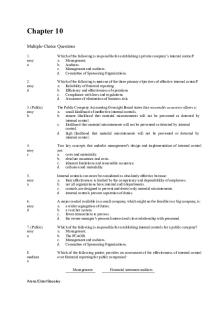
Chapter-10
- 19 Pages
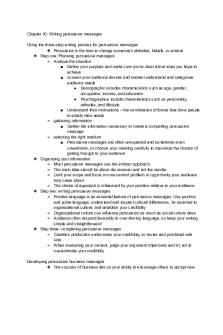
Chapter 10
- 5 Pages
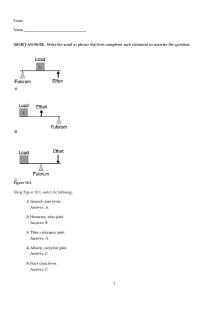
Chapter 10
- 14 Pages

Chapter 10
- 111 Pages
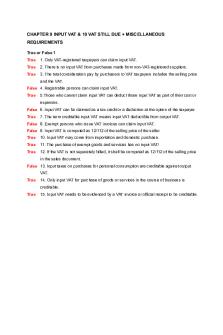
Chapter 10
- 16 Pages
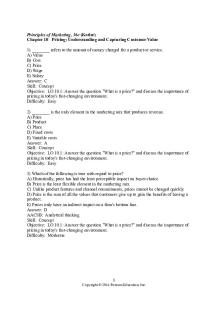
Chapter 10
- 47 Pages
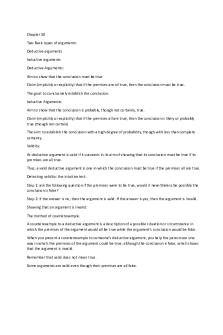
Chapter 10
- 4 Pages
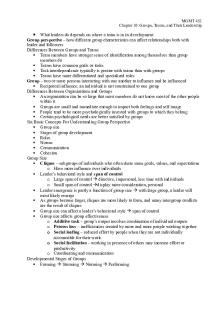
Chapter 10
- 5 Pages
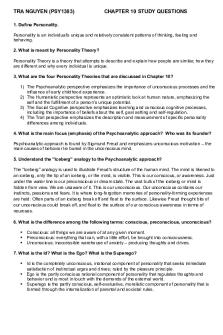
Chapter 10
- 6 Pages

Chapter 10
- 13 Pages

Chapter 10
- 10 Pages

Chapter 10
- 3 Pages

Chapter 10
- 22 Pages
Popular Institutions
- Tinajero National High School - Annex
- Politeknik Caltex Riau
- Yokohama City University
- SGT University
- University of Al-Qadisiyah
- Divine Word College of Vigan
- Techniek College Rotterdam
- Universidade de Santiago
- Universiti Teknologi MARA Cawangan Johor Kampus Pasir Gudang
- Poltekkes Kemenkes Yogyakarta
- Baguio City National High School
- Colegio san marcos
- preparatoria uno
- Centro de Bachillerato Tecnológico Industrial y de Servicios No. 107
- Dalian Maritime University
- Quang Trung Secondary School
- Colegio Tecnológico en Informática
- Corporación Regional de Educación Superior
- Grupo CEDVA
- Dar Al Uloom University
- Centro de Estudios Preuniversitarios de la Universidad Nacional de Ingeniería
- 上智大学
- Aakash International School, Nuna Majara
- San Felipe Neri Catholic School
- Kang Chiao International School - New Taipei City
- Misamis Occidental National High School
- Institución Educativa Escuela Normal Juan Ladrilleros
- Kolehiyo ng Pantukan
- Batanes State College
- Instituto Continental
- Sekolah Menengah Kejuruan Kesehatan Kaltara (Tarakan)
- Colegio de La Inmaculada Concepcion - Cebu
